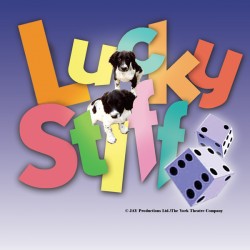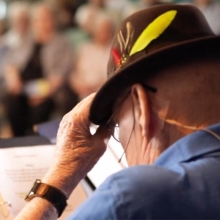Filichia Features: Lucky Stiff – It’s Good to Be Alive
Filichia Features: Lucky Stiff – It’s Good to Be Alive
We’ve seen plenty of teenagers in productions of The Boy Friend, Children Of Eden and Godspell. But Lucky Stiff?
Isabel Carrington, who runs the Warner Theatre Performance Lab for young performers in Torrington, Connecticut, had seen an adult cast perform the off-Broadway hit. Now she believed that her talented troupe could manage it.
But doesn’t Lucky Stiff have a scene in which Harry Witherspoon and Annabel Glick wind up having a one-night stand after an evening of non-stop drinking? How would this strike the parents of the teens playing these roles? Even if their moms and dads didn’t object, would some theatergoers find the scenes inappropriate?
No one’s been calling for either Carrington’s resignation or head. Lucky Stiff was a solid success with heavily populated houses during the May 17-19 Litchfield County run.
What helped is that bookwriter-lyricist Lynn Ahrens established that after Harry and Annabel had awakened, they were deeply ashamed of what they’d done. As they crawled out of bed, they were too embarrassed to even look at each other. Whatever judgment the audience was making probably wasn’t as severe as the verdict Harry and Annabel had handed themselves.
Carrington helped, too. She had both Joey Calabrese and Rachel Traub express nervousness commensurate with being in a nuclear power plant after an alarm had gone off. Another smart contribution came from costume designer Johanna DeZurik who put Calabrese in white boxer shorts emblazoned with red hearts. This helped the scene to be more comic and not at all erotic.
The drinking and debauching scenes are the only ones that might cause some directors, performers and audience members to think twice before producing a teen-filled Lucky Stiff. But aside from those, it’s clear sailing for companies that put teens in, as the show describes itself, “a madcap murder mystery musical farce.”
It started out as a genuine murder mystery when Michael Butterworth wrote his 1983 novel The Man Who Broke the Bank at Monte Carlo. However, Ahrens and her composer Stephen Flaherty saw the potential to make the tale funny rather than ominous.
Indeed it is, although the spine of the show is sincere. Harry Witherspoon is a shoe salesman in East Grinstead, England. His life has been as exciting as – well, East Grinstead, England. How he envies what he sells, for he would love to be “doing all the things all you shoes get to do.”
Actually, he does experience some excitement each night when he returns to the boarding house where he resides. Too many fellow residents keep enormous and menacing dogs. True, their barks may be worse than their bites, but their bites are still pretty biting. Harry has come to hate every canine in the animal kingdom.
But Harry will soon have a real adventure in Monte Carlo with his Uncle Anthony, who may well leave him six million American dollars. That may sound wondrous, but as was the case with so many musicals from the early 20th century – from Alma, Where Do You Live? (1910) to Zip! Goes a Million (1919) -- the prospect of Big Money comes with a Big Condition. Uncle Anthony has died, and will leave Harry the money if the lad takes him on a whirlwind tour of Atlantic City. Never mind that he’s dead: Uncle Anthony still wants to witness roulette at 10, take in the ocean air at 11, go nightclubbing at midnight and enjoy plenty of other treats during the day.
And what if Harry cannot pass off his uncle as a feeble-but-alive invalid in a wheelchair and perform each and every chore? He’ll forfeit the six million that will then go to Uncle Anthony’s favorite charity. And wouldn’t you know that it’s The Universal Dog Home of Brooklyn?
That’s where Annabel comes in. She’s the representative for the home for unwed and unwanted dogs. In trying to get the money for the Pomeranians, poodles, pugs and other pooches now in the pound, Annabel will have the single-mindedness of two dogs fighting over a bone. She’ll keep a careful eye on Harry to ensure that he follows each instruction to the letter.
These are the times that will try this man’s soul and soles. As he sings in one of Ahrens’ best lyrics, “No dogs are going to get their paws on it.”
And yet, if Harry and Annabel had met under normal circumstances, they would have experienced love at first sight and been crazy for each other. Their respective agendas, goals – and money – are keeping them diametrically opposed. (Another reason why teens can do well by this show is that money. All kids learn long before puberty that money hits the spot and solves quite a few problems, so they can relate to a tale where people would do almost anything to get it.)
Carrington had Calabrese and Traub excel in making a strong connection the second that they saw each other. How well they mixed their looks of longing with their looks of loathing. We came to care for them so much, a situation that doesn’t often make its presence known in farces.
What farces always have, however, is other people to complicate matters. Lucky Stiff obliges by offering us Dr. Vincent “Vinnie” DiRuzzio and his sister Rita LaPorta. He’s an optometrist whose life is going merrily along until he learns that she’s killed a man – no less than Harry’s Uncle Anthony. She’s after money, too, although not the inheritance. Seems that there’s this heart-shaped box …
In the grand tradition of Georges Feydeau, the world’s greatest farceur, Rita has a physical flaw: she’s terribly nearsighted. Because she hates to wear glasses, she’ll mistake someone’s identity. What farce doesn’t involve that complication?
Gwen Mileti was hilarious as the low-class but high-maintenance Rita. How brassy she was every time she came down to brass tacks. As Vinnie, Zach Roberts provided an equal amount of fun as the scared rabbit who tried not to lose his head – either emotionally or literally from some decapitating-inclined gangster. It’s a good role for a boy who wears glasses. After all, don’t all optometrists?
Of course the trademark of farce is the slamming door. Alas, with only enough funds to allow Les Ober to provide a barebones unit set, no doors could be afforded. Carrington had to compensate – and did admirably -- in getting her kids on and off with the speed of summer lightning. Performers popped in and out of the wings so swiftly and emerged from the cyclorama in lickety-split time that they were always one step ahead of the audience.
Not Uncle Anthony, however. Because he spends virtually the entire musical sitting in a wheelchair with his eyes closed, this is a nice part for an actor who’s never set foot on a stage. Be forewarned, however, that a fantasy sequence demands that he jump up to do an impromptu tap dance. That’s where Jeremy Piontkewicz showed that he wasn’t just interested in sitting down on the job.
Harry gets a soft-shoe, too, which is apt for a shoe salesman. But the only other real dancing in the show is a conga line, one of the easiest “dances” to accomplish.
That happens in a Monte Carlo nightclub, where Emma Seyer was terrific as emcee who knew just how much to shake her shoulders before introducing the headliner. She was Dominique du Monaco, an ideal role for an entertainer whose impulse is to go over the top. Alia Miller made the audience “ooh” at many of her “ooh-la-las” and was so good at manipulating a boa that she could have knocked over many an audience member with one of its feathers.
Flaherty’s marvelous melodies aren’t beyond the reach of teens. In the 30 years in which he and Ahrens have been collaborating – a time when musical theater has become more rock-centric – they have been the torchbearers of the classic traditional Broadway sound. If you feel that Lucky Stiff (their first show) doesn’t have much name recognition, advertise it as “the musical from the Tony-winning authors of Ragtime” and/or “the team that brought you Once On This Island.”
For a farce, Lucky Stiff has an ending that’s quite endearing. When the money is actually to be dispensed, Harry is suddenly arguing in favor of the dogs and Annabel is going to bat for Harry. It’s similar to The Wizard of Oz, in which Scarecrow demands of the Wizard near film’s end, “What about the heart that you promised Tin Man and the courage that you promised Cowardly Lion?” – and not a selfish “Where’s the brain you promised me?” Similarly, Tin Man and Cowardly Lion ask on behalf of Scarecrow and not themselves before making a plea to get Dorothy home. To see characters look out for others before themselves is heartwarming, and Harry and Annabel do just that.
Have you been asking yourself why a dead man would want to be escorted around a resort that he can’t see, hear, taste, touch or smell? Ah, but give Ahrens and Flaherty enough rope, and they’ll rope you in with a surprise that makes perfect sense. So follow Carrington’s lead and surprise your audiences with Lucky Stiff. They just might agree with one of its songs -- that it’s “Good to Be Alive.”

Read all of Filichia’s Features!
Visit Peter’s Official Website.
Check out Peter’s weekly column each Tuesday at www.masterworksbroadway.com and each Friday at www.kritzerland.com.
Peter’s newest book, Strippers, Showgirls, and Sharks: A Very Opinionated History of the Broadway Musicals That Did Not Win the Tony Award,is available for pre-order NOW!
Read more http://mtiblog.mtishows.com/filichia-features-thoroughly-modern-millie-grazie/


























